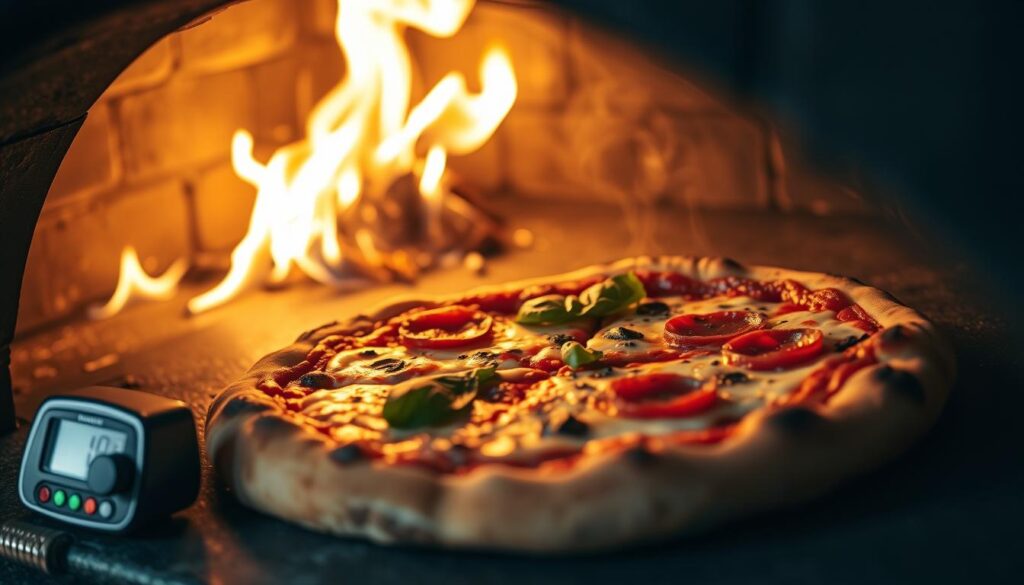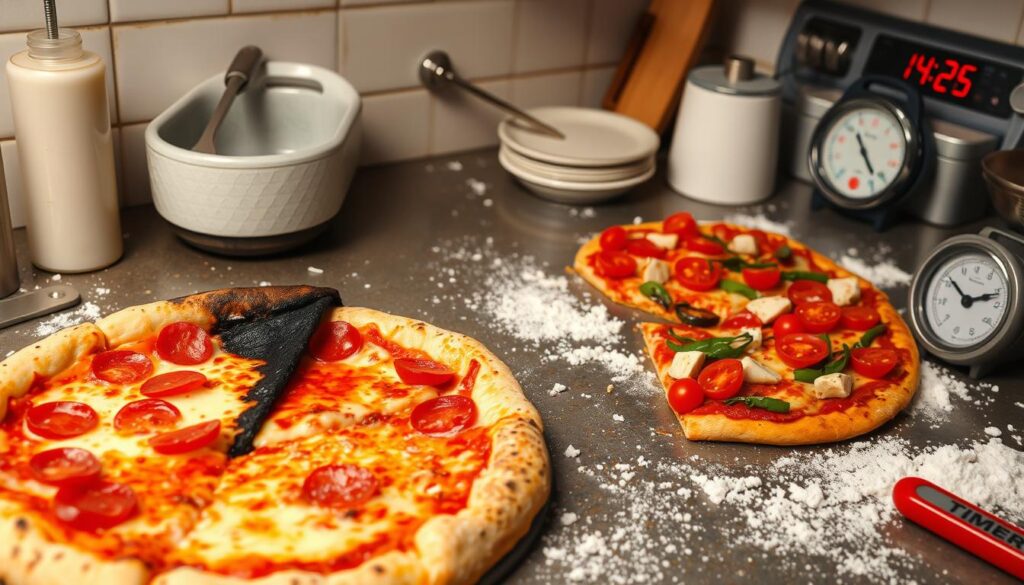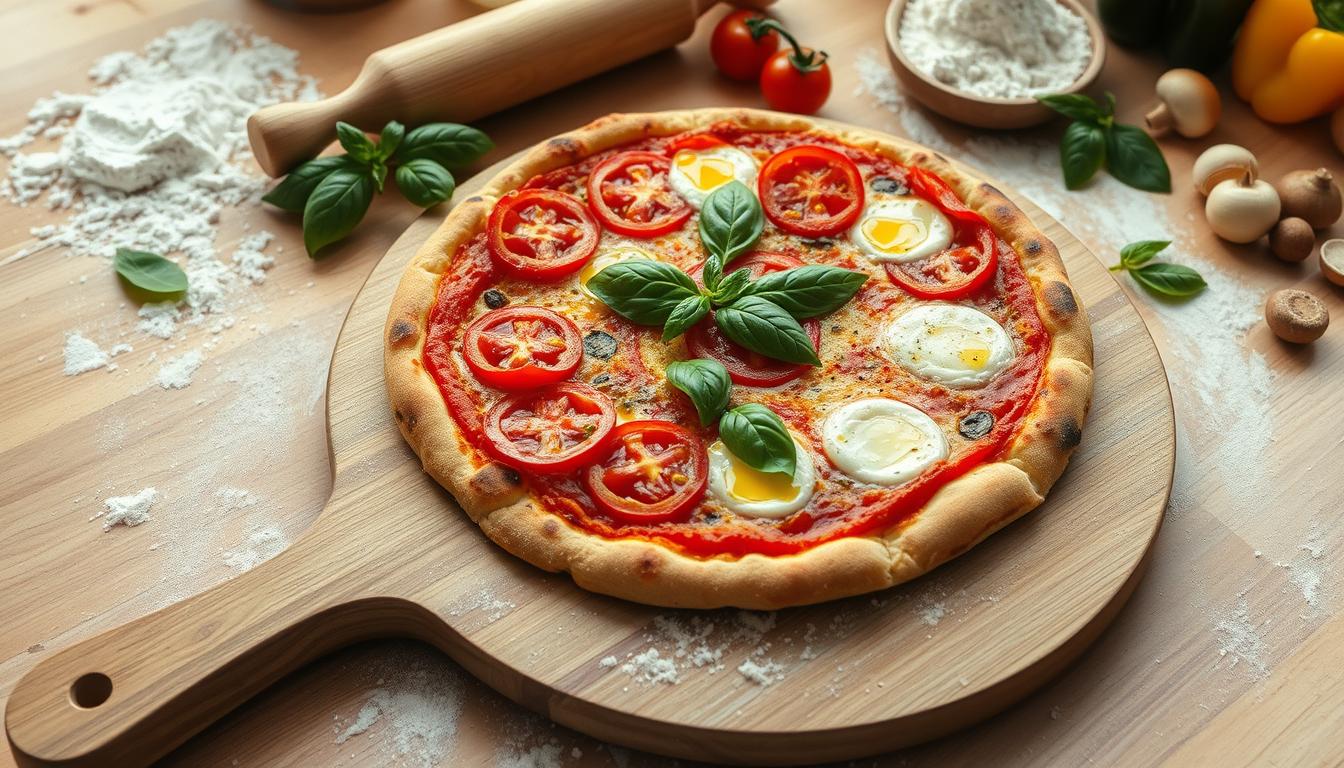Making homemade pizza is a fun and rewarding experience. It allows for customization and quality control. With the right ingredients and techniques, anyone can create a delicious homemade pizza. Quality ingredients, proper techniques, and the right equipment are essential for a great homemade pizza. You can find many homemade pizza recipes online, each with its own unique twist and flavor profile.
Homemade pizza offers numerous benefits, including cost-effectiveness and customization options. It also brings the satisfaction of creating a delicious meal from scratch. Whether you’re a seasoned cook or a beginner, making homemade pizza is a great way to experiment with new flavors and ingredients. You can choose from a variety of pizza recipes, including Margherita Pizza, Roasted Red Pepper Pesto Pizza, and Peach & Basil Pizza, to name a few.
Key Takeaways
- Making homemade pizza can be a fun and rewarding experience
- Quality ingredients, proper techniques, and the right equipment are essential for a great homemade pizza
- Homemade pizza offers numerous benefits, including cost-effectiveness and customization options
- There are many pizza recipes available, each with its own unique twist and flavor profile
- Homemade pizza is perfect for entertaining purposes, as guests can customize their meals to suit their preferences
- Seasonal eating is emphasized, particularly regarding pizza toppings sourced from local farmers markets and personal herb gardens
- 96% of people would make the pizza recipe again, indicating a high level of satisfaction with homemade pizza
With the right guidance and techniques, anyone can create a delicious homemade pizza. By following a few simple steps and using quality ingredients, you can make a homemade pizza that rivals your favorite restaurant. For more information on sustainability and eco-friendly living, visit news1.pizzacream.com to learn more about making a positive impact on the environment.
Essential Equipment for Cooking Pizza at Home
To make a tasty homemade pizza, having the right tools is key. A pizza stone or steel surface is crucial for a crispy crust. It holds heat well, just like a professional oven. Also, a pizza peel is vital for safely moving the pizza in and out of the oven.
Choosing the right baking equipment is important. A pizza stone or steel can be used in a regular oven. But, you’ll need a pizza peel for moving the pizza. Temperature control tools are also helpful for precise cooking.
Some top picks for pizza stones and peels include:
* The Original Baking Steel, available for $129 on Amazon
* Wooden peels, like those from The Baker’s Board, priced at $57 on Amazon
* Thin-bladed metal peels, such as the one from American Metalcraft, for $27 on Amazon
| Equipment | Price | Features |
|---|---|---|
| Pizza Stone | $129 | Retains heat, crispy crust |
| Pizza Peel | $27 | Safe transfer, easy to use |
Investing in the right gear, like a pizza stone, peel, and baking tools, lets you make pizzas as good as those from pizzerias.
Understanding Pizza Dough Basics
To craft a tasty homemade pizza, grasping the fundamentals of pizza dough is key. A quality pizza dough recipe demands specific ingredients. These include bread flour, yeast, water, salt, and sometimes olive oil or sugar. The flour type greatly influences the crust’s texture and taste, with bread flour yielding a crisper result.
The dough fermentation process is vital. It enables yeast to break down sugars, producing carbon dioxide. This gives the dough its light, airy quality. A slow fermentation, like a 24-hour room temperature rise followed by 24-48 hours in the fridge, boosts flavor and texture. For more insights, visit the pizza cream website.
Key considerations for making pizza dough include:
- Choosing a strong flour, like organic bread flour, high in protein
- Ensuring the dough rises for 24-48 hours
- Using the correct amount of yeast and salt for fermentation control
- Storing the dough in a cool, dry spot, like a Baking Steel Dough Container
By adhering to these guidelines and employing a superior pizza dough recipe, you can produce a delectable homemade pizza. Always opt for fresh, high-quality ingredients. Don’t hesitate to experiment with various toppings and flavors to discover your preferences.
The Perfect Pizza Sauce Recipe
To craft a delicious homemade pizza, a superior pizza sauce recipe is essential. A basic sauce can be created with canned whole tomatoes, salt, and an immersion blender. For a richer taste, consider a homemade pizza sauce recipe that incorporates grated onions, pressed garlic, and a mix of dried seasonings.
High-quality ingredients and slow reduction are crucial for a great pizza sauce. Canned whole tomatoes are the top choice for homemade pizza sauce. Fresh Roma tomatoes, about 1½ – 1¾ pounds, can also be used as a substitute.
Here are some tips for crafting the perfect pizza sauce:
- Use canned whole tomatoes for the best flavor
- Slowly reduce the sauce to intensify the flavors
- Add a blend of dried seasonings, such as oregano, basil, and red pepper flakes
- Use an immersion blender to puree the sauce to your desired consistency
A superior pizza sauce balances sweetness and acidity. Achieve this by mixing tomato puree with diced tomatoes. The sauce can be refrigerated for up to a week or frozen for up to 3 months.
With these tips and a top-notch pizza sauce recipe, you can create mouthwatering homemade pizzas. Whether you’re new to pizza making or experienced, a great sauce is the cornerstone of a fantastic pie.
| Ingredient | Quantity |
|---|---|
| Canned whole tomatoes | 1 (28-ounce) can |
| Extra-virgin olive oil | 1 tablespoon |
| Unsalted butter | 1 tablespoon |
| Garlic | 2 medium cloves |
| Dried oregano | 1 teaspoon |
Mastering the Art of Cooking Pizza
To perfect pizza cooking techniques, preheat the oven for at least 30 minutes. Use the highest oven temperature for pizza, up to 550°F, for the best results. This ensures even heat and a crispy crust.
Popular pizza ovens for home use include the Marsal SD-236 BASE SECT-LP Liquid Propane Deck Type Slice Series Pizza Oven and the Omcan USA 11387 14.3″ W x 3.3″ H Opening Single Deck Countertop Conveyor Oven. These ovens offer high oven temperatures for pizza and aid in mastering pizza cooking.
When employing pizza cooking techniques, consider crust thickness, topping distribution, and cooking time. Cook the pizza for 10-12 minutes, until the crust is golden and the cheese is melted and bubbly. For more on sustainable cooking practices, explore online resources.
Here are some tips to enhance your pizza cooking techniques:
- Use a pizza stone to absorb moisture and distribute heat evenly.
- Pre-bake the crust for a few minutes to prevent sogginess.
- Monitor the temperature and adjust the cooking time as needed.
By adhering to these tips and honing your pizza cooking techniques, you’ll soon craft delicious, homemade pizzas that match those from your favorite pizzeria.
Choosing the Right Toppings
The selection of toppings is key to crafting the ideal pizza. With so many choices, picking the perfect mix can seem daunting. Yet, by grasping the traditional topping order, you can achieve a pizza that’s both tasty and well-cooked.
Traditionally, pizzas start with tomato sauce, followed by cheese, and then the toppings. This sequence ensures the cheese melts and the toppings cook evenly. This results in a pizza that’s both flavorful and textured. Some favorite combinations include:
- Pepperoni and Olive
- Chicken and BBQ
- Prosciutto and Arugula
- Sausage and Cheese
But don’t be afraid to try unique pairings like pineapple and bacon or pesto and chicken. The goal is to blend flavors and textures that enhance each other.
When picking toppings, think about their cooking needs. Place toppings that need more cooking, like raw meat or veggies, on top. This way, they’ll cook fully. By choosing the right toppings and mixing them thoughtfully, you can make a pizza that’s both delicious and fulfilling.
Temperature and Timing Guidelines
Mastering the art of baking pizza at home requires understanding the perfect pizza oven temperature and pizza baking time. Achieving a crispy crust and melted cheese hinges on these factors. Home bakers should aim for oven temperatures between 475°F and 550°F, with 500°F being the sweet spot.
Professional pizza ovens can soar past 900°F, but for home use, preheating to at least 475°F is key. This ensures a good crust. The cooking duration varies with oven type and crust thickness. Here’s a quick guide:
| Oven Type | Cooking Time |
|---|---|
| Wood-Fired Pizza Oven | 60-90 seconds |
| Gas Pizza Oven | 5-7 minutes |
| Conventional Oven | 10-15 minutes (thin crust), 15-20 minutes (thick crust) |
By adhering to these guidelines, you can craft a pizza with a golden crust and bubbly cheese. Keep an eye on the pizza baking time and adjust the pizza oven temperature accordingly for optimal results.

Different Styles of Homemade Pizza
Exploring homemade pizza styles reveals a world of flavors and textures. From the classic Neapolitan pizza to the iconic New York pizza and the hearty Chicago pizza, the choices are vast. Understanding each style’s crust, toppings, and preparation is key to mastering homemade pizza.
Neapolitan Style
Neapolitan pizza boasts a thin crust, a soft center, and fresh toppings like tomato sauce, mozzarella, and basil. Hailing from Naples, Italy, it’s often seen as the original pizza.
New York Style
New York pizza is renowned for its large, thin, foldable slices. It’s topped with a light sauce and a mix of mozzarella and other cheeses. The crust is crispy on the bottom and chewy inside.
Chicago Style
Chicago pizza, or deep-dish pizza, features a thick crust baked in a deep pan. It’s topped with a thick cheese layer, meats, and vegetables. The crust turns golden, and the cheese bubbles during baking.
For more on making various homemade pizzas, check out Taste of Home. They offer a range of recipes and cooking tips.
Common Pizza Cooking Mistakes to Avoid
When cooking pizza at home, it’s easy to fall into common pitfalls that can ruin the dish. Pizza cooking errors can range from undercooked or overcooked crusts to unevenly distributed toppings. To avoid these mistakes, it’s essential to understand the underlying causes and take preventative measures. For instance, not letting the dough proof for long enough can result in a hard, dense pizza base. On the other hand, properly proofing the dough for 24 hours in the fridge can lead to a soft, pillowy, and chewy pizza base.
Some common mistakes include overloading the pizza with too many toppings, which can lead to an uneven, soggy pizza that is difficult to eat. Troubleshooting pizza issues like these can be achieved by following simple guidelines. For example, letting the pizza cook for an extra five minutes beyond melting the cheese ensures the dough is fully cooked through.
To avoid pizza cooking errors, it’s crucial to follow proper techniques and guidelines. This includes kneading the dough for around 10 to 12 minutes or using a stand mixer with a dough hook. Cooking the pizza at 500 degrees Fahrenheit is also key. By being aware of these common mistakes and taking steps to prevent them, home cooks can create delicious, homemade pizzas that rival those from professional pizzerias.

By understanding and addressing potential pitfalls, home cooks can improve their troubleshooting pizza skills and create perfect pizzas every time. With practice and patience, anyone can become a skilled pizza maker. They can craft delicious, homemade pizzas that are sure to impress.
Advanced Pizza Making Techniques
For those aiming to enhance their pizza-making prowess, mastering pizza dough stretching and professional baking methods is crucial. Professional pizza techniques include employing a pizza peel for transfer and removing parchment paper during baking for a crisper crust.
Advanced pizza making encompasses several key aspects:
- Utilizing a micro dose of 1 gram of yeast per 500 grams of flour for optimal dough rising
- Employing cold fermentation for 24-72 hours to enhance flavor and texture
- Opting for room temperature fermentation for a quicker process, with careful monitoring to prevent over-fermentation
By honing these pizza dough stretching and professional pizza techniques, home cooks can craft pizzas that stand alongside those from pizzerias. With dedication and persistence, anyone can become proficient in making delicious, authentic pies.
| Pizza Style | Crust Thickness | Cooking Time |
|---|---|---|
| Neapolitan | Thin | 10-12 minutes |
| New York | Medium | 12-15 minutes |
| Deep Dish | Thick | 20-25 minutes |
Storing and Reheating Leftover Pizza
Pizza is a staple in many households, with many people consuming it at least once a week. When it comes to storing and reheating leftover pizza, there are several options to consider. Proper pizza storage can help maintain the quality of the pizza, while reheating pizza can be done in a variety of ways to achieve the perfect texture and flavor.
For short-term storage, pizza can be kept in the refrigerator for up to 5 days. For longer-term storage, freezing is a great option, with pizza able to be preserved for up to 6 months. When it comes to reheating, there are several methods to choose from, including the oven, microwave, skillet, and air fryer. Each method has its pros and cons, with the oven and skillet providing a crispy crust and the microwave and air fryer offering a quick and easy solution.
| Reheating Method | Temperature | Time | Result |
|---|---|---|---|
| Oven | 475°F | 4-5 minutes | Crispy crust and heated toppings |
| Microwave | 50% power | 1 minute | Soft crust and heated toppings |
| Skillet | Medium heat | 6-8 minutes | Crispy crust and heated toppings |
| Air Fryer | 350°F | 2-4 minutes | Crispy crust and heated toppings |
Ultimately, the best method for reheating pizza will depend on personal preference and the equipment available. By following these tips and guidelines, you can enjoy your leftover pizza almost as much as when it was freshly baked. Proper pizza storage will help maintain its quality.
Conclusion: Perfecting Your Pizza Making Journey
Embarking on your pizza making journey reveals the true joy in the process. Creating the perfect homemade pizza is a labor of love. It involves selecting the right flour, measuring accurately, and kneading and proofing with care. With each pie, your pizza making skills will improve, and the joy of serving a delicious, restaurant-quality pizza will be immense.
Whether aiming to master the classic Margherita or to try gourmet toppings, embracing the art of pizza making is key. Try different dough recipes, experiment with sauces, and let your creativity with toppings shine. The beauty of homemade pizza is in its customization to your taste.
Continuing your pizza making tips journey, always keep learning and improving. Look for new recipes, watch tutorials, and connect with the vibrant pizza enthusiast community online. With persistence and dedication, you’ll soon impress your family and friends with your homemade pizza creations. You’ll find the joy of making a delicious homemade pizza in your own kitchen.
